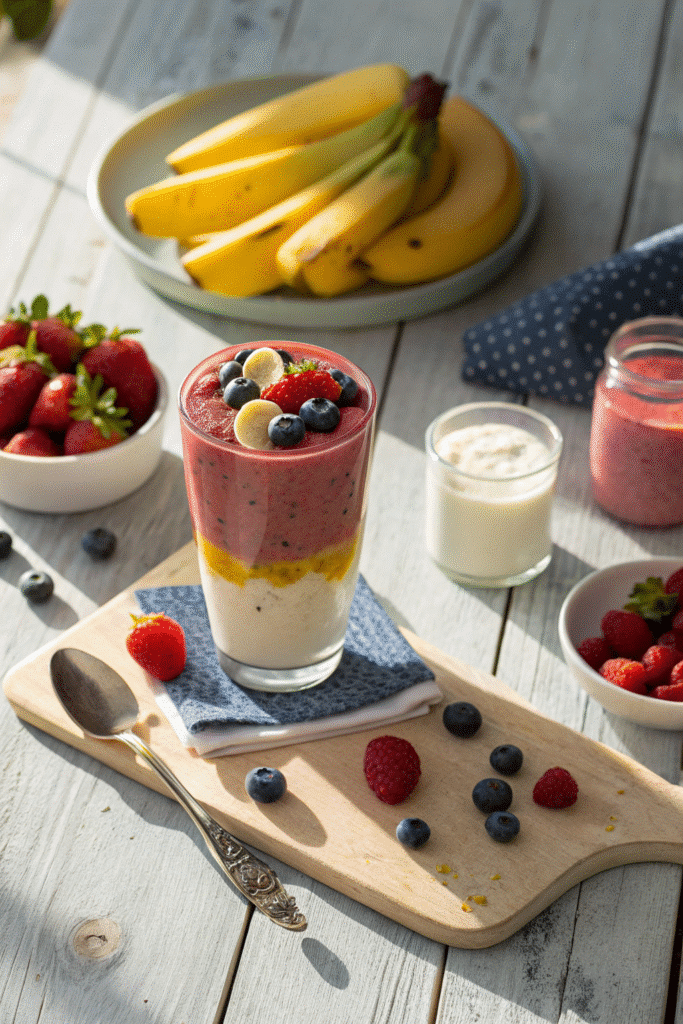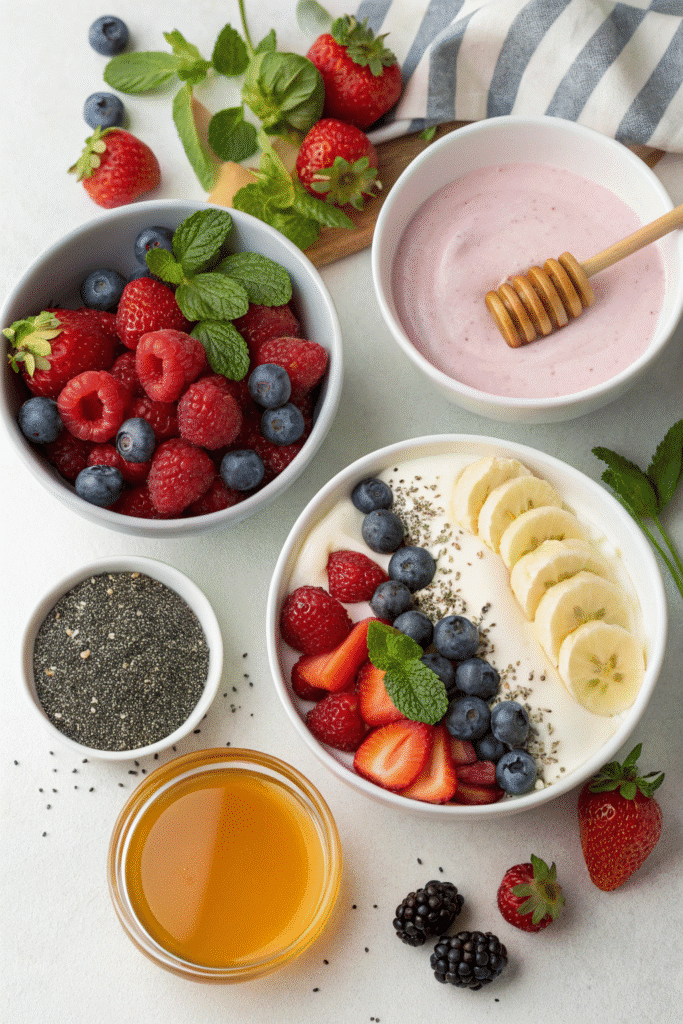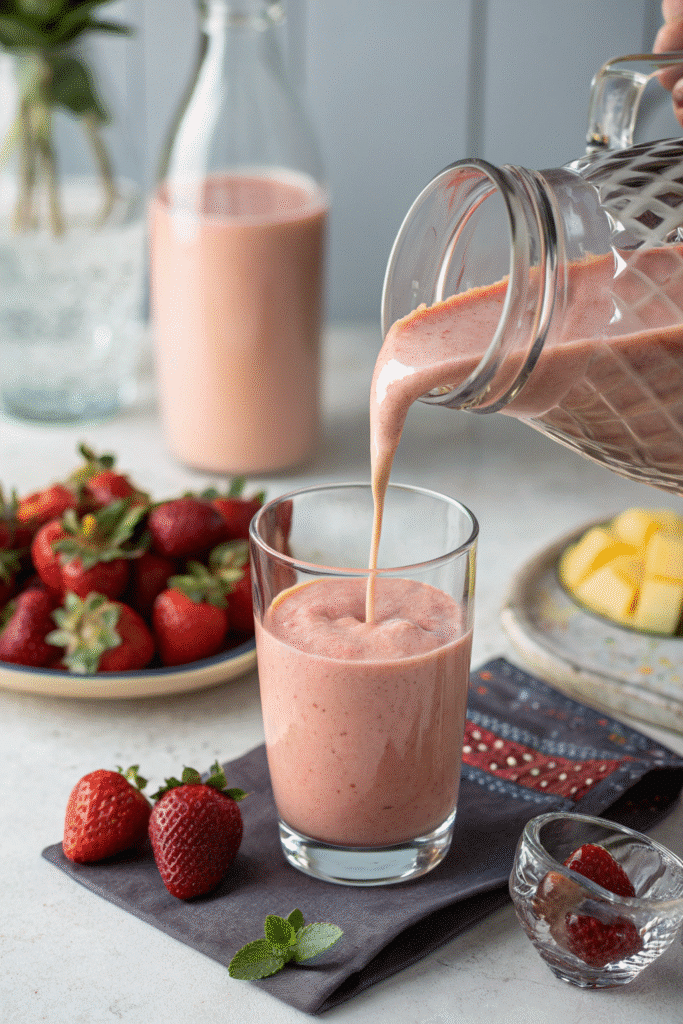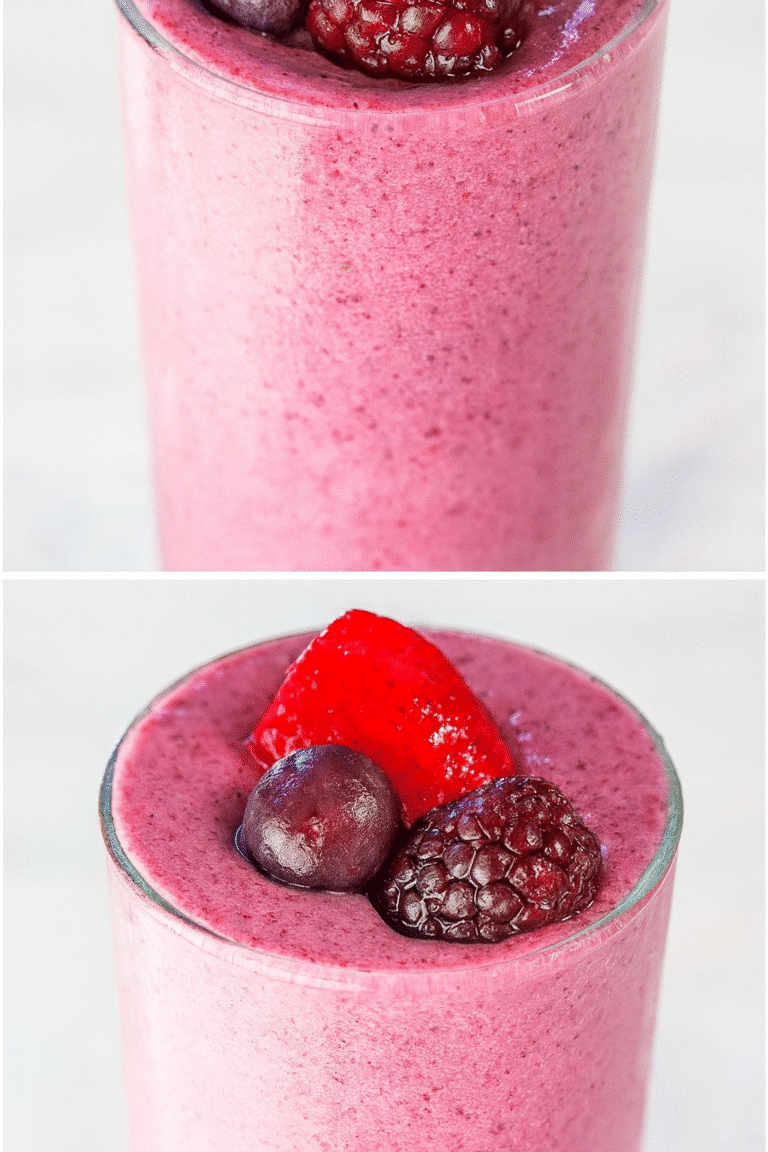Ever had one of those mornings where you really don’t feel like cooking, but you still want something healthy, filling, and a little indulgent? That’s where a fruit and yogurt smoothie swoops in like a breakfast superhero! In fact, studies show that blending fresh fruit with yogurt can provide over 30% of your daily calcium and fiber needs in just one glass. Whether you’re craving a berry burst, tropical sunshine, or a protein-packed workout drink, smoothies are quick, versatile, and endlessly customizable. In this guide, I’ll share my favorite recipes, health tips, and pro tricks so you can whip up your perfect blend—fast!

Health Benefits of Fruit and Yogurt Smoothies
I didn’t always think a smoothie could be “real” breakfast food. Back in my early 30s, I figured breakfast meant something solid — eggs, toast, maybe pancakes on a good day. Then a friend handed me a tall glass of strawberry-yogurt smoothie after a morning walk, and I felt full until lunch. That was the day I realized a smoothie isn’t just a drink — it’s a nutrient-packed meal in disguise.
Protein That Actually Fills You Up
Yogurt, especially Greek yogurt, is like your protein bodyguard. One cup can pack 10–15 grams of protein, which means you’re not looking for snacks an hour later. I started adding it to my blends not just for the creaminess, but because I could actually make it to lunchtime without raiding the pantry. Plus, yogurt has probiotics — the friendly bacteria that keep your gut running smoothly. I used to deal with bloating more often than I’d like to admit, but that eased up when I made yogurt a regular thing.
A Vitamin and Antioxidant Explosion
The fun part of smoothies is mixing fruits. Bananas are great for potassium and natural sweetness, but when you throw in blueberries, strawberries, or mangoes, you’re getting a rainbow of vitamins. Blueberries help fight inflammation, strawberries bring a vitamin C punch, and mangoes load you up with vitamin A for healthy skin and eyes. I even sneak in cherries now and then for their deep flavor and joint-friendly antioxidants.
Keeping the Sugar in Check
Not all smoothies are automatically healthy — I learned that the hard way. When I first started, I used sweetened yogurt and fruit juice, and my sugar intake shot up. Sure, it tasted like dessert, but I’d crash before noon. Now I use plain yogurt and let the natural fruit sugars shine. If I need extra sweetness, I’ll toss in a couple of dates or a drizzle of honey. It’s enough to satisfy my sweet tooth without giving me that jittery spike-and-crash feeling.
Extra Hydration Without Thinking About It
Smoothies can help you sneak in more hydration, especially if you use frozen fruit or ice. On hot summer days, I can sip one of these and feel way more refreshed than if I tried to chug plain water. It’s like hydration in disguise.
For me, fruit and yogurt smoothies are this perfect combo — protein for staying power, vitamins for energy, and probiotics for gut health — all in one glass. And yes, sometimes I drink mine from a mason jar with a striped straw, because healthy food should be fun.

Essential Ingredients for the Perfect Smoothie
If there’s one thing I’ve learned after years of smoothie-making, it’s that the magic happens before you even turn on the blender. The ingredients you choose — and how you balance them — can mean the difference between a thick, creamy, “wow” smoothie and a sad, watery one you force yourself to finish.
The Yogurt Base
I’ve experimented with them all — regular yogurt, Greek yogurt, plant-based yogurt. Greek yogurt is my go-to for protein and creaminess. It gives smoothies a thick, satisfying texture and keeps me full longer. If you’re dairy-free, coconut or almond milk yogurt works great too, though it tends to be a little thinner. Pro tip: if you want a dessert-like smoothie, try vanilla Greek yogurt (unsweetened if possible) — it’s like a built-in flavor boost.
Fresh vs. Frozen Fruit
This is where personal preference comes in. Fresh fruit gives you a lighter, fresher taste, while frozen fruit adds body and acts as its own ice. I usually keep frozen blueberries, strawberries, and mango chunks in the freezer so I can whip up a smoothie anytime without worrying about spoilage. One summer, I learned the hard way that fresh bananas left on the counter for “just a few days” can turn into fruit fly bait… frozen is safer.
Add-Ins for Nutrition and Flavor
A basic fruit-and-yogurt combo is great, but I like to throw in extras depending on my mood or needs. Chia seeds for fiber and omega-3s. A spoonful of peanut butter for protein and a nutty kick. Oats for a heartier, breakfast-style smoothie. Even a pinch of cinnamon if I’m doing a banana base — trust me, it tastes like banana bread in a glass.
Balancing Creaminess and Sweetness
This is the tricky part. Too much yogurt and it’s heavy; too much fruit and it’s overly sweet. My general ratio is one cup of yogurt to one and a half cups of fruit. If I’m using tart fruit like raspberries, I’ll add a bit of honey or a date. If the fruit is already sweet (like ripe mangoes), I don’t add anything at all.
Liquid for the Right Blend
Don’t skip the liquid — it’s what gets your blender moving. I use milk, almond milk, or just plain water depending on what I have. About half a cup is enough for most blends; add more if you want it thinner.
The best smoothies I’ve made have been a balance — creamy yogurt, flavorful fruit, a couple of thoughtful add-ins, and just enough liquid to pull it all together. Once you nail that combo, you’ll never have a bland smoothie again.

Easy Fruit and Yogurt Smoothie Recipes
Here’s the fun part — actually making the smoothies. Over the years, I’ve tested dozens of blends, from “Pinterest pretty but barely drinkable” to “so good I made it three mornings in a row.” The four recipes below are my go-to’s. They’re quick, reliable, and each has its own personality.
Classic Mixed Berry Smoothie
This is my weekday workhorse. I use a mix of blueberries, strawberries, and raspberries — usually frozen, because they make the smoothie thick without needing ice. I toss in Greek yogurt, a splash of almond milk, and sometimes a teaspoon of honey if the berries are tart. This one’s packed with antioxidants, which makes me feel like I’m doing something good for my future self while I’m still in pajamas.
Tropical Mango-Pineapple Blend
If I close my eyes while drinking this, I swear I can hear ocean waves. Frozen mango chunks, pineapple, banana, and coconut milk yogurt make it creamy and tropical. I once made this for friends during a backyard barbecue, and it disappeared faster than the chips and salsa. Bonus: the vitamin C from the pineapple is a solid immunity booster.
Protein-Packed Banana Peanut Butter Smoothie
This one’s a lifesaver on mornings when I need extra fuel — like before a long hike. I blend one frozen banana, two tablespoons of peanut butter, Greek yogurt, a splash of milk, and a pinch of cinnamon. It tastes like dessert but keeps me going for hours. I once tried almond butter instead, but peanut butter just hits differently here.
Green Smoothie with Spinach and Avocado
I know “green smoothie” scares some people, but hear me out: the fruit hides the greens completely. I use half an avocado for creaminess, a big handful of spinach, frozen mango, banana, and yogurt. The result is smooth, slightly sweet, and not grassy at all. I started making this after realizing I could easily sneak in a serving of greens without chewing a salad at 7 a.m.
The beauty of these recipes is how forgiving they are. Out of strawberries? Use cherries. No yogurt? Swap in silken tofu or a plant-based alternative. The key is to keep your ratios right and taste as you go. And yes, I’ve had mornings where I overdid the spinach or accidentally added salty peanut butter… but hey, that’s how you learn what works.

Tips for Making the Creamiest Smoothie
I’ve made my fair share of smoothies that looked great in the blender but somehow turned thin and sad in the glass. Getting that thick, velvety texture takes more than just tossing fruit and yogurt together — it’s all about the right ingredients, order, and a few sneaky tricks I’ve picked up over the years.
Start with Frozen Fruit
Frozen fruit is my number one secret. Not only does it keep the smoothie cold without watering it down, but it also gives it body. I keep bags of frozen bananas, berries, and mango in my freezer at all times. If I’m using fresh fruit, I’ll throw in a handful of ice cubes, but honestly, frozen fruit wins every time for creaminess.
Use Greek Yogurt or Avocado for Body
Greek yogurt has a thicker consistency than regular yogurt, which helps create that spoon-worthy texture. On dairy-free days, I’ll use half an avocado — it blends silky smooth and adds healthy fats that keep me satisfied. I learned the avocado trick from a café owner who swore it kept customers coming back just for the texture.
Mind Your Liquid Ratio
This one’s big. Too much liquid and you’ll end up with smoothie soup. I usually start with about half a cup of liquid (milk, almond milk, or water) and only add more if the blender struggles. It’s easier to thin out a smoothie than to fix one that’s already too runny — I learned that after one unfortunate “berry milk” incident.
Blend in Stages
I used to dump everything in at once, but blending in stages makes a huge difference. Start with the yogurt and liquid, then add your frozen fruit and extras. If you’re adding greens, tuck them in between layers so they get fully blended. This keeps the texture uniform instead of grainy.
Add Extras at the End
For an extra creamy boost, I sometimes blend in a spoonful of nut butter or a small handful of rolled oats at the very end. The oats soak up liquid as they sit, so the smoothie thickens slightly even after you pour it. Just don’t overdo it — unless you want to be eating your smoothie with a spoon (which, honestly, is sometimes the goal).
Creamy smoothies aren’t an accident — they’re the result of a few smart choices. Once you nail the frozen fruit, yogurt base, and liquid control, you’ll get that dreamy texture every time. And trust me, it’s a lot more satisfying than sipping something that feels like fruity water.

Fruit and yogurt smoothies are more than just a quick breakfast—they’re a flavor-packed, nutrient-dense treat you can enjoy anytime. With the right ingredients and a few tricks, you can create blends that rival any café creation. So, grab your blender and start experimenting! If you found these tips helpful, pin your favorite recipe on Pinterest and share the smoothie love.
Print
Fruit and Yogurt Smoothie
A creamy, protein-packed fruit and yogurt smoothie that’s healthy, filling, and customizable with your favorite fruits and add-ins.
- Total Time: 5 minutes
- Yield: 2 servings 1x
Ingredients
- 1 cup Greek yogurt (or plant-based yogurt)
- 1 1/2 cups mixed fresh or frozen fruit (e.g., berries, mango, banana)
- 1/2 cup milk, almond milk, or water
- Optional: 1 tablespoon honey or 2 pitted dates for sweetness
- Optional add-ins: chia seeds, peanut butter, oats, spinach, avocado
Instructions
- Add yogurt and liquid to the blender.
- Add fresh or frozen fruit.
- Include any optional add-ins (chia seeds, peanut butter, oats, spinach, avocado).
- Blend until smooth and creamy.
- Taste and adjust sweetness if needed with honey or dates.
- Pour into a glass or jar and enjoy immediately.
Notes
For a thicker smoothie, use frozen fruit or reduce liquid. For a dairy-free version, use plant-based yogurt and milk alternatives.
- Prep Time: 5 minutes
- Cook Time: 0 minutes
- Category: Beverage
- Method: Blended
- Cuisine: American
Nutrition
- Serving Size: 1 smoothie
- Calories: 200
- Sugar: 20g
- Sodium: 60mg
- Fat: 4g
- Saturated Fat: 2g
- Unsaturated Fat: 1.5g
- Trans Fat: 0g
- Carbohydrates: 35g
- Fiber: 4g
- Protein: 10g
- Cholesterol: 10mg


